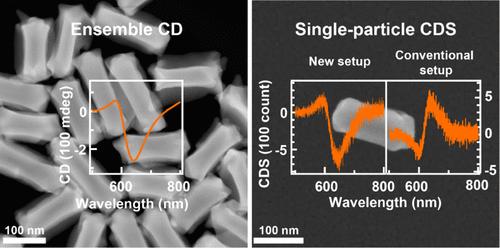手性和非手性金纳米棒圆差散射测量中伪影的消解和检测限的提高
IF 16
1区 材料科学
Q1 CHEMISTRY, MULTIDISCIPLINARY
引用次数: 0
摘要
圆微分散射(CDS)光谱已经发展成为表征单个等离子体纳米结构及其与手性分子配合物的光学活性的有力方法。然而,标准的测量设置经常导致长期以来对光谱数据解释的担忧。事实上,CDS设置的检测极限受到高水平伪影的限制,为±10%。我们通过对圆偏振光在暗场聚光器上反射时偏振态变化的详细理论描述来解决这个问题。因此,我们提出了一种基于四分之一波片和线性偏振器顺序放置在检测光程内的改进CDS配置,以分析单个粒子散射光的圆偏振状态。广泛的分析表明,改进后的配置的检测限为±1.5%,明显低于传统设置。作为CDS测量的标准系统,非手性和手性金纳米棒(aunr)都使用这两种设置进行了表征。对于非手性aunr,发现传统设置中的线性二色性(LD)伪影源于激发光中存在的LD,并且仅在各向异性激发由于激发光与聚光镜的不对准而产生时才存在。对于手性aunr,用常规装置记录的CDS光谱取决于手性aunr相对于显微镜x轴的方向,并且与在胶体上和在修改配置下测量的CDS光谱相反。结果与理论模拟结果吻合较好。本文章由计算机程序翻译,如有差异,请以英文原文为准。

Resolving Artifacts and Improving the Detection Limit in Circular Differential Scattering Measurement of Chiral and Achiral Gold Nanorods
Circular differential scattering (CDS) spectroscopy has been developed as a powerful method for the characterization of the optical activity of individual plasmonic nanostructures and their complexes with chiral molecules. However, standard measurement setups often result in artifacts that have long raised concerns on the interpretation of spectral data. In fact, the detection limit of CDS setups is constrained by the high level of artifacts, to ±10%. We address this issue by means of a detailed theoretical description of changes in the polarization state when circularly polarized light is reflected at a dark-field condenser. As a result, we propose a modified CDS configuration based on sequentially placing the quarter-wave plate and linear polarizer within the detection optical path, to analyze the circular polarization state of the light scattered by individual particles. Extensive analysis demonstrates a detection limit of ±1.5% for the modified configuration, which is significantly lower than that for the conventional setup. As a standard system for CDS measurements, both achiral and chiral gold nanorods (AuNRs) were characterized using both setups. With achiral AuNRs, linear dichroism (LD) artifacts in the conventional setup are found to originate from LD present in the excitation light and are only present if anisotropic excitation is produced as a result of the misalignment of the excitation light to the condenser. With chiral AuNRs, CDS spectra recorded with the conventional setup depend on the orientation of the chiral AuNRs with respect to the x-axis of the microscope and are reversed compared to those on the colloid and measured in the modified configuration. The results are in good agreement with theoretical simulations for both configurations.
求助全文
通过发布文献求助,成功后即可免费获取论文全文。
去求助
来源期刊

ACS Nano
工程技术-材料科学:综合
CiteScore
26.00
自引率
4.10%
发文量
1627
审稿时长
1.7 months
期刊介绍:
ACS Nano, published monthly, serves as an international forum for comprehensive articles on nanoscience and nanotechnology research at the intersections of chemistry, biology, materials science, physics, and engineering. The journal fosters communication among scientists in these communities, facilitating collaboration, new research opportunities, and advancements through discoveries. ACS Nano covers synthesis, assembly, characterization, theory, and simulation of nanostructures, nanobiotechnology, nanofabrication, methods and tools for nanoscience and nanotechnology, and self- and directed-assembly. Alongside original research articles, it offers thorough reviews, perspectives on cutting-edge research, and discussions envisioning the future of nanoscience and nanotechnology.
 求助内容:
求助内容: 应助结果提醒方式:
应助结果提醒方式:


